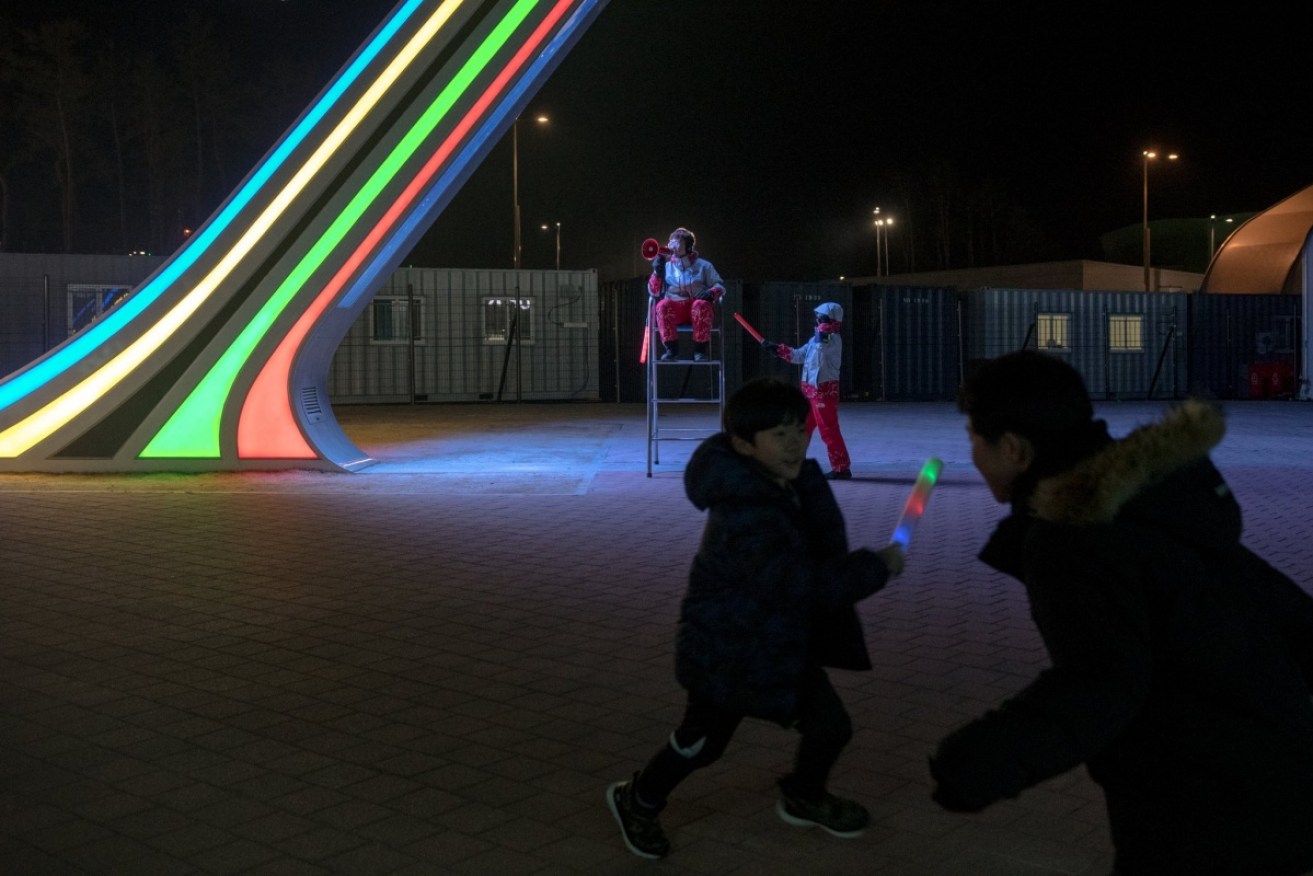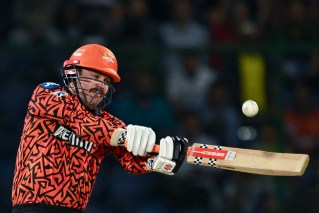Why the Pyeongchang Games are different from all the others

Children play in front of a neon sculpture at Gangneung Olympic Park. Bright colours abound at these Games. Photo: Hilary Swift/NYT
In the Gangneung Hockey Centre, the four-faced video screen in the middle of the rink puts on a show every time a penalty is called. Words like “Interference” and “Tripping” materialise in turquoise blue and start to giddily flip-flop around, in both English and Korean. You’d think someone just won the lotto.
Nope. “Delay of Game.”
Every Olympics is a fusion of the generic, staid look of the Games, as mandated by the International Olympic Committee, with the singular aesthetic of the hosting country. It is what gives these biennial extravaganzas, which stage nearly identical competitions in a different part of the world, their distinctive feel.
More than anything, being here – at two clusters of venues on the shores of the Sea of Japan and in the Taebaek Mountains – is a feast for the senses. Your palette is regularly lit up by the food, which is super spicy, or super sweet, or sometimes a bit of both. You can be freezing outdoors one moment and sweating in an overheated bus the next. Your eardrums get a workout anywhere there is music.
Then there are the bright colours and brash graphics, a combination found everywhere, especially on television. A number of shows have word bubbles that make the classic “bloop!” sound as they pop up over the action, in shades lifted from a pack of Starburst fruit chews.

Brash graphics blanket the Olympics, including at the Pyeongchang Super Store, where volunteers stand ready to help. Photo: Hilary Swift/NYT
Just about everything here is bold, you soon notice, including the flavours. The shelves in convenience stores sell snacks that make their American counterparts seem timid and bland. Here is squid’s body with peanut butter. There is a strawberry sandwich with what is either cheese or frosting. Try some crab stick; or Spam with kimchi gimbap; or pig’s trotters, which on the packaging gets a grinning thumbs-up from a guy in a red bow tie.
It takes a cab ride beyond the Olympic bubble, but Pyeongchang has many restaurants with two-hour, multicourse dinners that sound like a tour of the ocean. Sea anemone, sea squirts, raw trout, live octopus, and the list goes on and on. Closer by are places that lay a tilted skillet on your table and start grilling pork. Heaven for a carnivore, rough on vegetarians. A menu item called “vegetables” means that some greens come with the pork.
At Olympic events, the noise of the colours is matched by the volume of the music. Like a lot of American sporting venue owners, the organisers here believe that unless the DJ is playing tracks at punishingly high levels, nobody is having fun. It’s even hard to shout over the commentators at cross-country skiing events.
The marriage of loud colours and sounds reaches its zany apogee at the hockey rink. The place has an official cheerleading group, four young women in short, pink dresses, who stand halfway up the stands and dance to songs like Happy by a Chinese-South Korean group called Cosmic Girls.

Cheerleaders at the hockey rink, waiting for a pause in the action and their chance to perform. Photo: Hilary Swift/NYT
On Wednesday night, the rink’s master of ceremonies interviewed a cheerleader before the third period and asked questions like, “How do you like being the official cheerleading group of the arena?” There was no translation, unfortunately, but the body language – a wide grin, jazz hands beside each ear – sufficed as an answer. Performances like this gin up what are sometimes sparse, relatively quiet crowds.
When they are not overloading your senses, the Games are showcasing tech. The official and ubiquitous motto “Passion. Connected” seems a subtle nod to South Korea’s leading role in helping to wire the world, most notably through the success of Samsung, a corporate sponsor.
Robots are a common sight, roaming around indoor settings and beaming the day’s schedule and weather forecast, projector-like, on the floor. The Super Store that sells official Olympic gear of every kind has an aquarium filled with swimming electronic fish. Many of the bus schedule kiosks have what appear to be high-definition screens and a Siri-like female voice offering real-time updates.
Sometimes these manage to be both precise and vague. Like: “Bus number 41 will leave in a while.”
Buses are the essential mode of transportation at these Games, which has been a problem for some spectators.

The Pyeongchang Super Store has an aquarium filled with electronic fish. Photo: Hilary Swift/NYT
“I understand this is probably crazy to organise, but none of the shuttles run as they’re supposed to,” said Lauren Andersen, one of the rare American fans here without a family connection to an athlete. She and her husband, both avid snowboarders, read about the dearth of ticket sales in November and decided, why not?
Organisers seemed to anticipate that would be a rare reaction. They set aside about 18,000 tickets for American fans, not quite enough to fill Madison Square Garden.
The Andersens spotted an opportunity and have no regrets. On Tuesday, they were rooting for American cross-country skiers as though they bet their house on the results. It took a few days to learn how to navigate the hassles, which began with a three-hour journey after the opening ceremony, which began when they were unable to find a bus back to their hotel. Fortunately, the couple was “rescued”, as Andersen put it, by a Korean missionary with a van, who was scooping up grateful stragglers.
“We gave money to his church,” she said.
The Andersens quickly abandoned the bus network for spectators and started riding the network for the news media. By contrast, it is a model of punctuality. The buses are also strikingly appointed, with a love for colour shining through on the seats, the seat backings and walls, which come in a variety of yellows, oranges, reds and purples. The underside of the luggage racks are sometimes lit up like rainbows.

Buses are the essential mode of transportation at the Games, and they come equipped with large TVs. Photo: Hilary Swift/NYT
Also, each is decked out with a large, flat panel television, hung at the front. The Martian was playing one day, live coverage of short-track speedskating another. Hop to it, American bus owners. You operate neglected living rooms in search of an interior decorator.
Lovely as they are, the buses have a pretty consistent flaw. They are heated to 150 degrees Fahrenheit (65 Celsius). OK, that’s an exaggeration. But it is common to spend hours outdoors shivering at an event and then step inside a vehicle that is sweltering. The transition from too cold to too hot occurs almost instantly. You’re only in that Goldilocks place of just right, temperature-wise, for about five seconds. Riders shed layers as fast as they can.
While television can leap instantly from one sporting venue to another, for those here it’s a drive that lasts between 20 to 40 minutes, unless you need a connecting bus, in which case, it’s longer. For many people, the Olympics is half sports watching, half bus riding.
What sets these Games apart isn’t the commuting – that’s common – it’s the layout. Typically, the core and soul of any Winter Olympics is wherever medal ceremonies occur, rather than the venues themselves. Sometimes those exalted stages aren’t far from sporting venues, and the feel of sport is all around.
Here, the ceremonies take place at the Pyeongchang Olympic Plaza, an asphalt park flanked by corporate pavilions and the otherwise unused stadium for both the opening and closing ceremony.

The slopes are empty at Alpensia Ski Resort, which is closed for the Olympics. Photo: Hilary Swift/NYT
There are no sporting venues or competitions close by, which means there is no centre, no town square. These might be the first Games afflicted with suburban sprawl. On the plus side, there is usually entertainment before the ceremony. One night it was the Korean Military Academy Band, a drumming sextet in red soldier outfits that weaves languid hip-hop moves into highly regimented music.
An obvious anchor for the mountain cluster would be the Alpensia Ski Resort, which was completed in 2011 but isn’t exactly bucket-list material for any skier. You might assume this would be a banner moment for this unheralded destination. Actually, the resort is closed for the Olympics. All those wide-empty slopes give the place a ghost-town vibe that is reinforced by the lack of crowds in the shops and restaurants, at least in the afternoons.
The energy is at the venues, of course, and it peaks whenever Korean athletes are competing. “All out frenzy” seems to be their preferred mode of cheering. Watch on South Korean television, and the announcers are often shouting in a way that does not seem good for their vocal cords.
Aside from fans, the South Koreans that spectators interact with the most are the young volunteers in white and red snow-resistant uniforms. They have fanned out in every direction to gamely answer the thousands of where-am-I-going? questions.
Often, the volunteers, who have some superhuman ability to stand in frigid weather for hours on end, are invaluable. That is never more true than the first time everyone’s cellphone emits a simultaneous beep, followed by a message on your screen that says, in English, “Extreme alert”. You urgently need someone to translate the next sentence, which is in Korean.

Cheerleaders from North Korea waving unity flags before the start of a hockey game. Photo: Hilary Swift/NYT
Initially, of course, the mind goes straight to nuclear Armageddon. Then you learn that these alerts land almost daily, and they provide, for instance, a heads-up about how dry weather could cause fires. During a super windy day, an extreme alert was issued about the wind. At some point, your cellphone beeps and you barely notice.
What lasts longer is the jet lag. There is a 14-hour gap between here and New York, and a 17-hour gap between here and Los Angeles. Even if you’re a seasoned traveler, this yields a stupor that actually reduces IQ. For the first day or two, words that were once readily accessible seem to be hiding.
This exacerbates a different challenge, namely grasping time in the rest of the world. It’s a matter of subtraction because Pyeongchang is ahead of the United States, not behind. Here, 10pm Eastern Time is noon the next day. Talk on the phone to anyone in the United States and you are living in their tomorrow. Globetrotters and expats here may think that is ho-hum. For everyone else, it’s a bit freaky.
Once acclimated, you can focus on everything that sets this place apart. Like its immaculateness. Venues are spotless. Before medal ceremonies, a video describes “Ceremony Etiquette”, which includes a reminder to keep the place clean by “putting the trash where it belongs!” Unlike plenty of other places – Fenway Park and Yankee Stadium come to mind – people seem to listen.
There is also an emphasis on politesse. When someone hands you something, it is rarely with one outstretched hand. Its either with two hands or with one hand touching the second near the elbow. The odd thing is that once you get used to it, the single outstretched hand from friends does start to feel a bit ill-mannered.

A view of the frosty scenery from inside a sweltering bus. Photo: Hilary Swift/NYT
For those watching at home, these Olympics may be remembered for the cold weather, or those North Korean cheerleaders, or for performances like that of the halfpipe prodigy Chloe Kim and others that have yet to come.
The same moments will resonate for attendees, too. But added to them will be the countless, you-had-to-be-there ways that South Korea’s iridescent style has been stamped on these Games. That’s the Olympics, forever the same and always different.
-The New York Times








